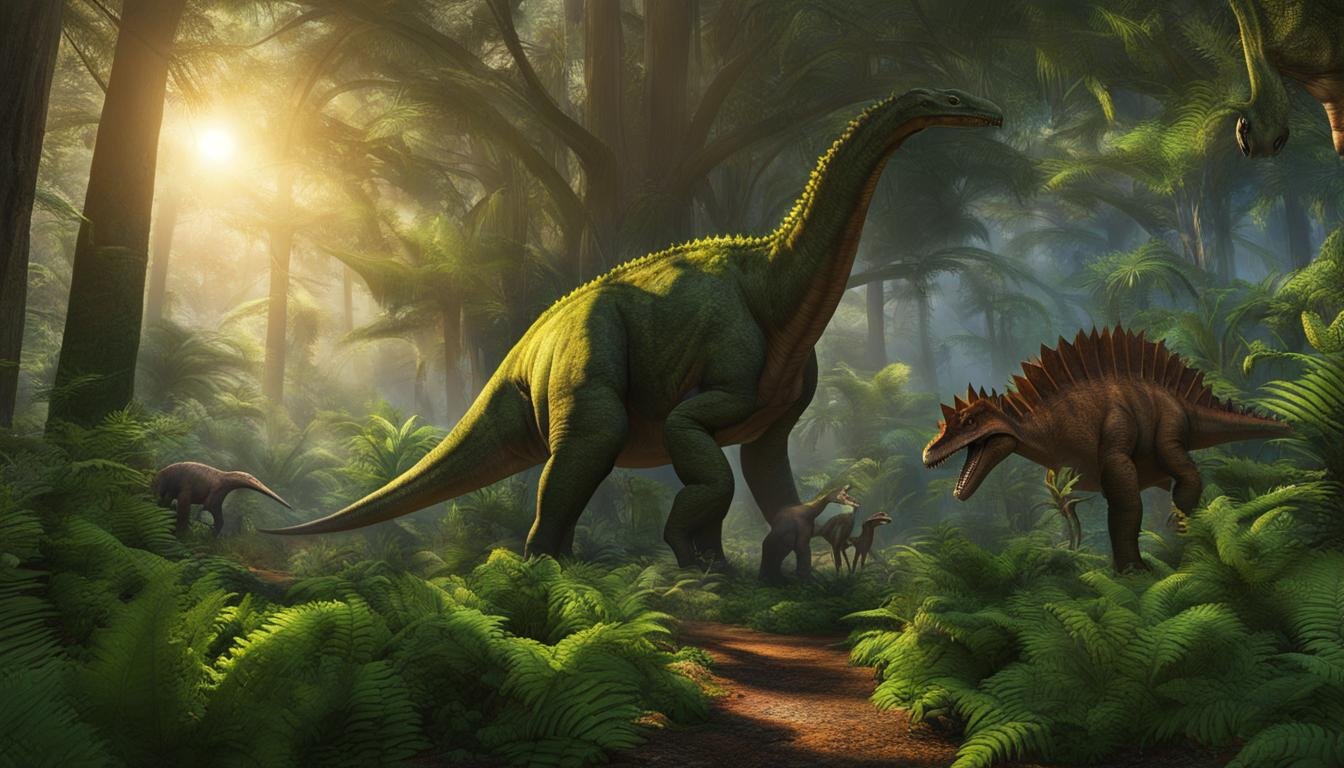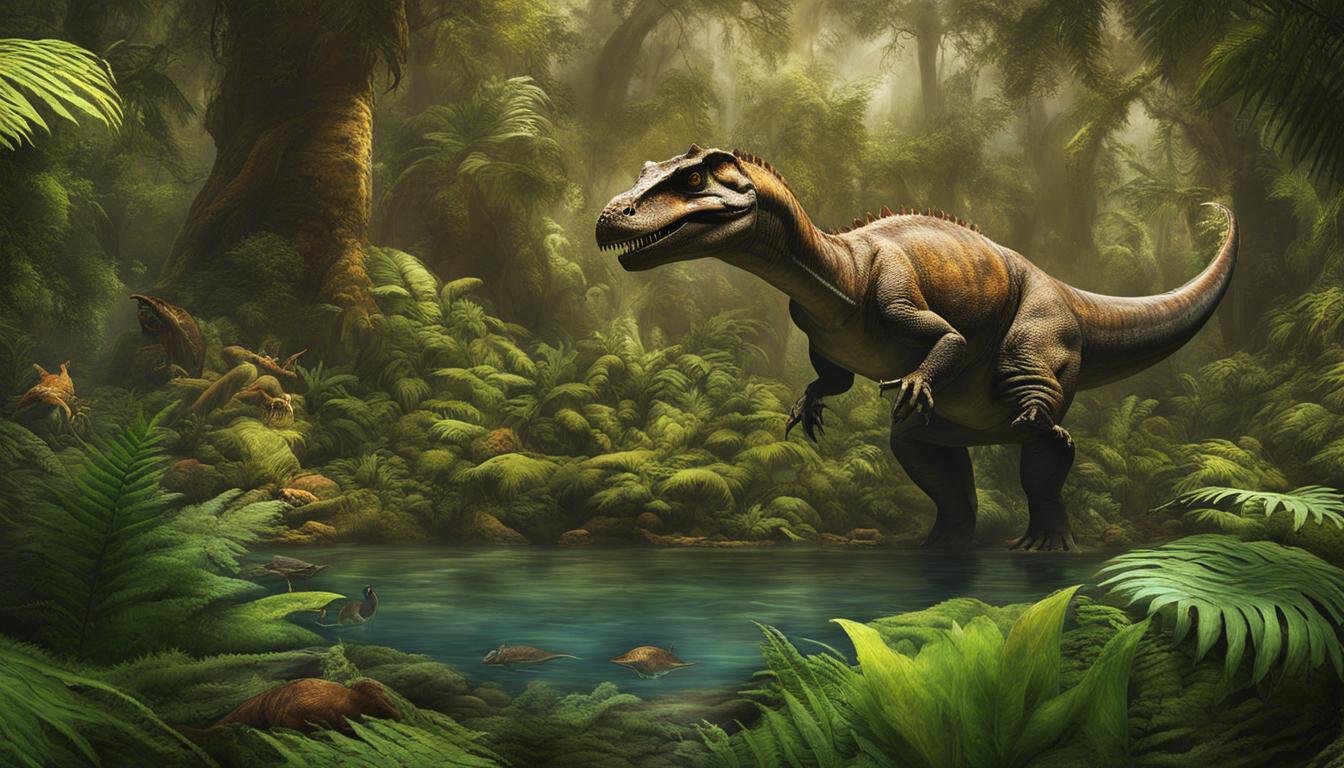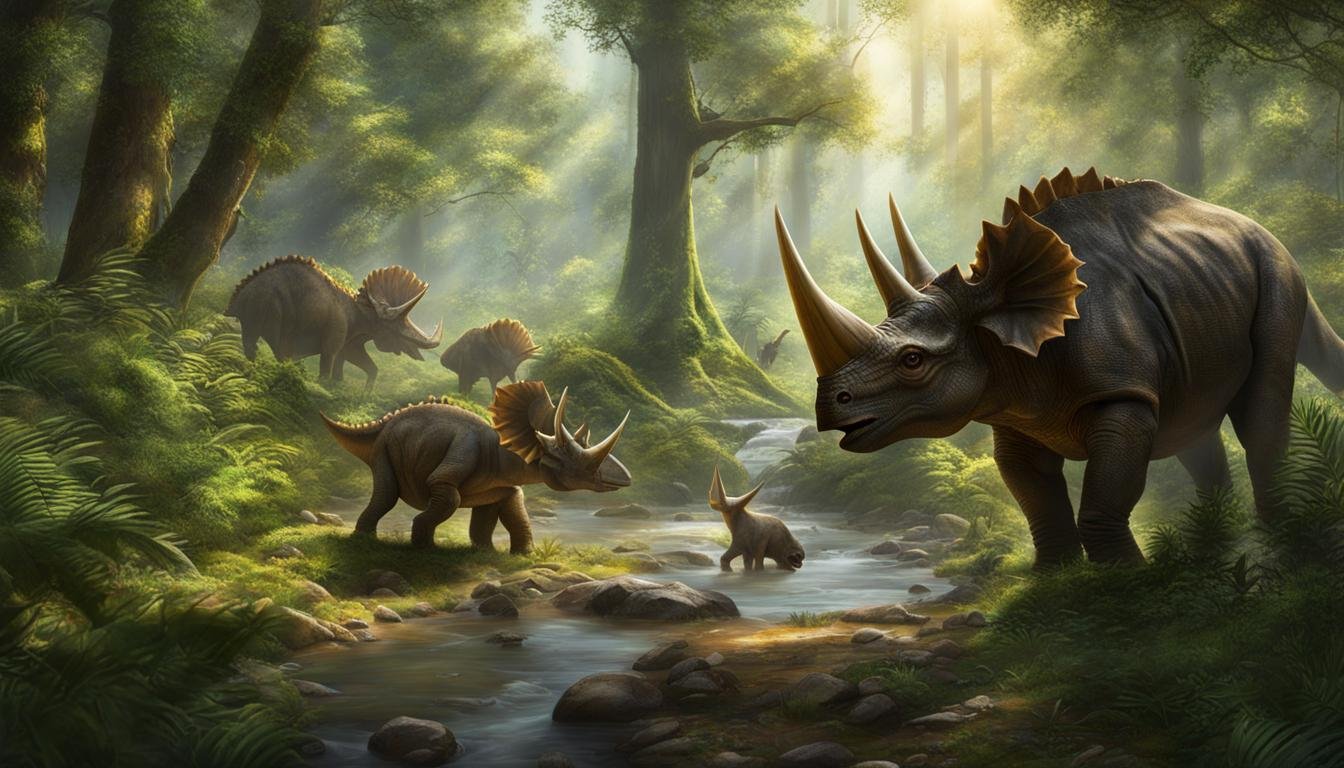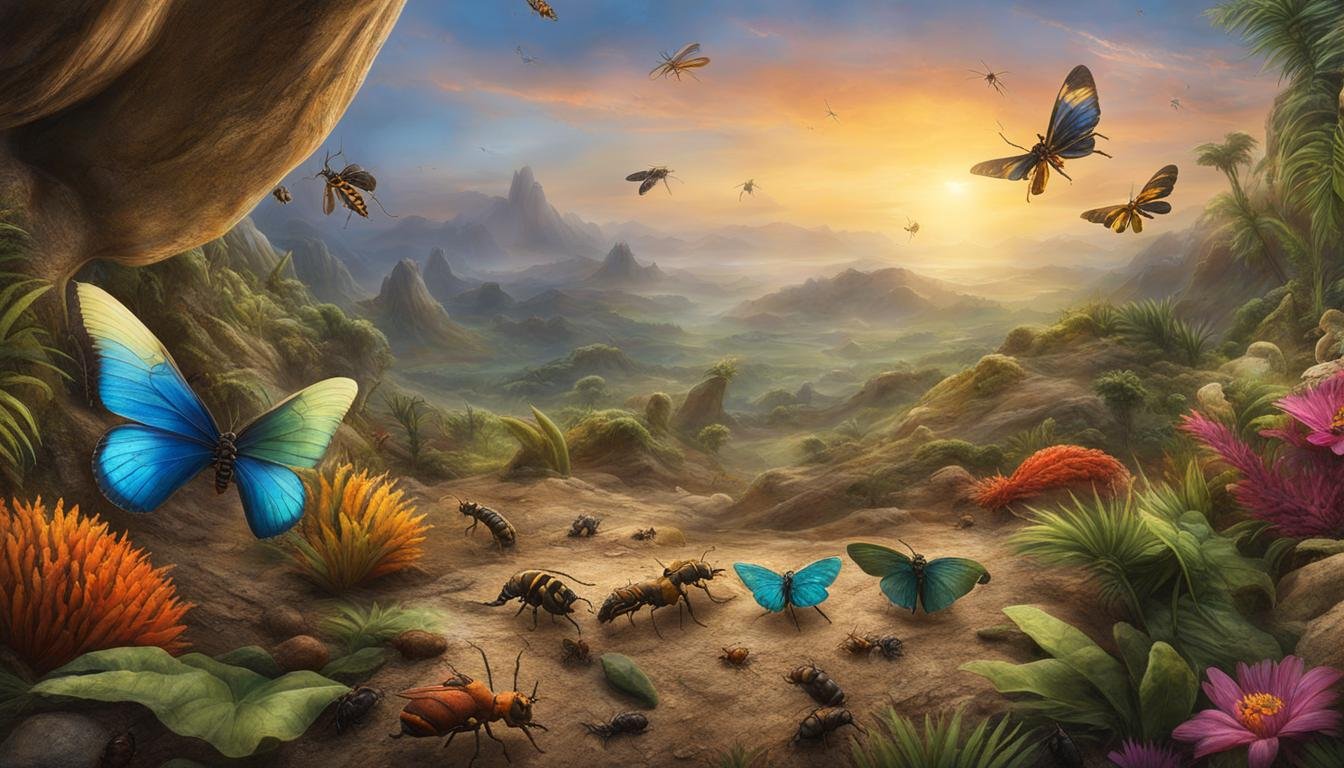Explore the fascinating relationship between dinosaurs and prehistoric flora in this captivating article. Discover how plants were more than just a backdrop to the dinosaurs—they played a significant role in their lives. Paleontologist Robert Bakker’s hypothesis that dinosaurs influenced the evolution of plants, particularly flowering plants, has been challenged by recent studies. However, evidence suggests that dinosaurs did have an impact on plant evolution, such as the influence of sauropod dinosaurs on the development of well-protected seed cones in conifer trees. Uncover the coevolutionary relationship between dinosaurs and plants to gain valuable insights into ancient ecosystems and the evolution of both groups.
| Main Point | Description |
|---|---|
| Coevolution of Dinosaurs and Flora | Dinosaurs and prehistoric plants shared a rich history of coevolution throughout their existence. |
| Dinosaur Impact on Plant Evolution | Although dinosaurs may not have been directly responsible for the origin or widespread development of flowers, they likely influenced plant evolution in some ways. |
| Plant Evolution in the Cretaceous Period | The Cretaceous Period marked a significant era for plant evolution, especially in the emergence and diversification of flowering plants. |
| Survival of Ancient Plant Lineages | Ancient plant groups like mosses, ferns, horsetails, and ginkgo trees have persisted to modern times, offering insights into the long history of plant evolution. |
| Plants and Pollinators Coevolution | The coevolutionary relationship between flowering plants and their pollinators, such as insects, was crucial to the success and diversity of these plants. |
The Cretaceous Period and Plant Evolution
The Cretaceous Period, spanning approximately 79 million years, played a pivotal role in the evolution of plants. This period witnessed the emergence and diversification of flowering plants, known as angiosperms. The rapid proliferation of angiosperms during the mid-Cretaceous era initially puzzled Charles Darwin, who believed that evolution occurred at a slower pace. However, the burst of floral diversity seen in the Cretaceous serves as evidence that evolution can indeed happen rapidly.
According to the fossil record, angiosperms appeared during the early Cretaceous, with some evidence suggesting the presence of Jurassic-era flowering plants. This emergence of flowering plants coincided with the rise of pollinating insects, such as bees and wasps, which played a crucial role in their diversification. The coevolutionary relationship between angiosperms and pollinators led to the development of various flower forms and pollination strategies, contributing to the success and abundance of flowering plants.
To better understand the significance of the Cretaceous Period in plant evolution, let’s take a look at the following table:
| Plant Group | Key Characteristics | Significance |
|---|---|---|
| Angiosperms (Flowering Plants) | Development of flowers, fruits, and seeds | Rapid diversification, successful coevolution with pollinators |
| Gymnosperms (Non-flowering Plants) | Reproduction via cones and exposed seeds | Decline in diversity, but some lineages persist today |
| Ferns and Mosses | Reproduction via spores, lack of seeds | Ancient lineages showing resilience and adaptation |
As shown in the table, the Cretaceous Period was a turning point in plant evolution, with the emergence of flowering plants leading to their widespread success. While gymnosperms, such as conifer trees, declined in diversity, they still persist today. Additionally, ferns and mosses, ancient lineages that reproduce through spores, showcase the resilience and adaptability of plants throughout geologic history.
Ancient Plants That Thrive Today
When we think of ancient plants, it’s easy to assume they’re long extinct. However, there are several plant lineages that have managed to survive through millions of years, providing us with a glimpse into the past. These living fossils offer valuable insights into the history of plant evolution and the remarkable adaptability of these organisms.
One group of ancient plants that still thrives today is mosses. These small, non-vascular plants were among the first to colonize land around 450 million years ago. Despite their simple structure and lack of roots, mosses have managed to persist using the same strategies as their ancient ancestors. They reproduce through spores and rely on moisture and shade to survive.
Ferns are another group of ancient plants that have stood the test of time. With a history spanning over 360 million years, ferns have evolved remarkable adaptations for survival. They reproduce via spores and have developed intricate systems for regulating water and nutrient flow, allowing them to thrive in a variety of environments.
| Living Fossils | Scientific Name | Time Period |
|---|---|---|
| Mosses | Bryophyta | 450 million years ago |
| Ferns | Pteridophyta | Over 360 million years ago |
| Horsetails | Equisetopsida | Over 300 million years ago |
| Ginkgo | Ginkgo biloba | Over 270 million years ago |
Horsetails, also known as Equisetopsida, are another ancient group of plants that have persisted since the time of dinosaurs. These plants appeared over 300 million years ago and were once consumed by dinosaurs. They are characterized by their hollow, jointed stems and spore-bearing cones.
The ginkgo tree, or Ginkgo biloba, is perhaps one of the most well-known living fossils. Dating back over 270 million years, ginkgo trees have remained virtually unchanged for millions of years. They have distinct fan-shaped leaves and are known for their resistance to disease and pollution.
These ancient plants showcase the diverse adaptations and resilience of plant life throughout geologic history.
Understanding these ancient plants and their survival strategies provides us with valuable insights into the history of plant evolution. They remind us of the long and intricate journey that plants have taken to adapt to changing environments over millions of years. These living fossils serve as a testament to the enduring power of nature and the remarkable tenacity of ancient plant lineages.
The Tenacity of Dinosaur Snacks and “Missing Link” Flowers
The coevolution of dinosaurs and prehistoric flora is a fascinating area of study, highlighting the intricate relationship between these ancient groups. One example of this coevolutionary dynamic can be seen in the monkey puzzle tree (Araucaria araucana), a living fossil that dates back to the time of dinosaurs. These trees served as a source of food for several dinosaur species, including the long-necked sauropods. The fact that these trees have managed to survive for millions of years is a testament to their resilience and their ability to adapt to changing environments.
Magnolias, another group of ancient plants, played a significant role in the evolution of flowering plants. These early magnolias, which originated around 100 million years ago, were pollinated by beetles. Their arrival marked a period of explosive diversification for flowering plants, as the coevolution between the magnolias and the beetles led to the development of intricate systems that allowed both groups to thrive. This coevolutionary relationship between plants and pollinators is a prime example of the interdependence between species and how it can drive evolutionary change.
Living fossils like the monkey puzzle tree and ancient magnolias provide valuable insights into the history of plant evolution and the coevolutionary systems that shaped our planet millions of years ago.
| Ancient Plant | Dinosaur Interaction |
|---|---|
| Monkey Puzzle Tree (Araucaria araucana) | Served as a food source for long-necked sauropods |
| Magnolias | Coevolution with beetles led to the diversification of flowering plants |
Studying these living fossils and the coevolutionary systems that existed between dinosaurs and plants provides us with a glimpse into the ancient ecosystems and the complex web of interactions that shaped our planet’s biodiversity. By understanding the past, we can gain insights into the present and make informed decisions to preserve and protect our natural world.
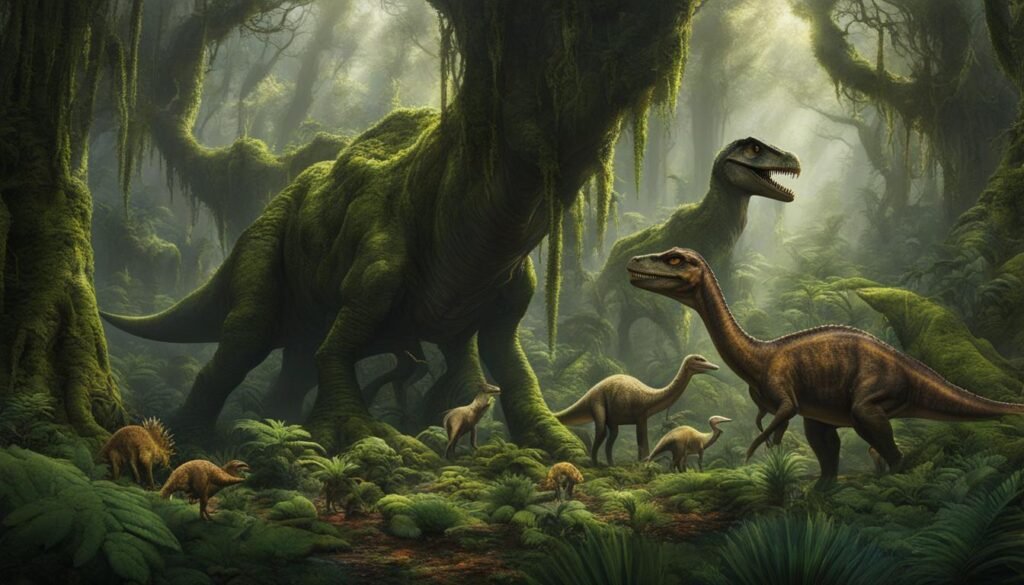
Conclusion
In conclusion, the coevolutionary patterns between dinosaurs and prehistoric flora provide valuable insights into ancient ecosystems. While dinosaurs may not have directly influenced the origin or spread of flowers, their presence likely played a role in plant evolution and the development of certain plant defenses. The Cretaceous Period witnessed the rapid diversification of flowering plants, which was facilitated by their coevolution with pollinating insects. This dynamic relationship led to the development of various flower forms and pollination strategies, contributing to the success and diversification of flowering plants.
Ancient plants that have survived to the present day, such as mosses, ferns, and ginkgo trees, offer glimpses into the history of plant evolution. These living fossils demonstrate the diverse adaptations and resilience of plant life throughout geologic history. Studying their coevolutionary interactions with their environment provides valuable information about the complex and dynamic nature of ancient ecosystems.
By examining plant-fossil interactions, scientists can uncover the intricate relationships between plants and their prehistoric counterparts. Understanding these interactions helps us better appreciate the coevolutionary patterns that shaped ancient Earth. The coexistence of dinosaurs and prehistoric flora was more than just a coincidence; it was a testament to the interconnectedness and interdependency of life in these ancient ecosystems.

